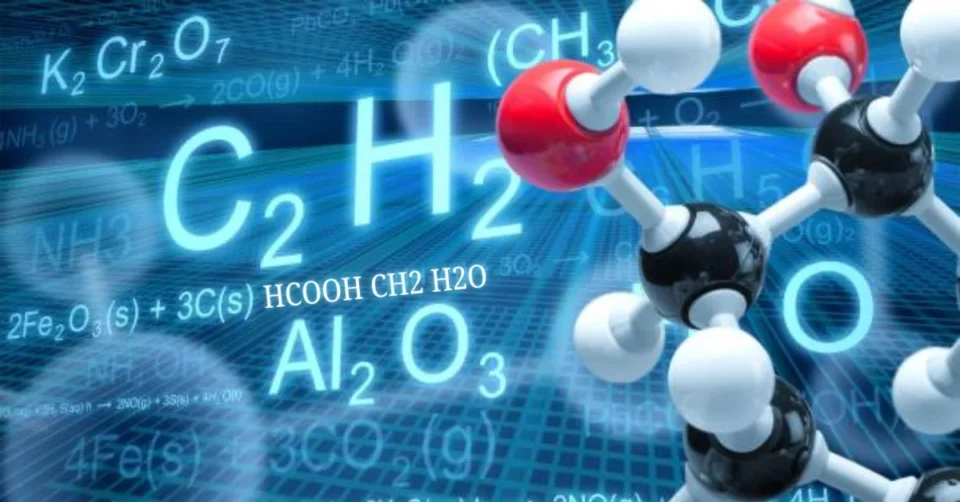Introduction to HCOOH CH2 H2O
Have you ever stumbled across the intriguing formula HCOOH CH2 H2O and wondered what it truly represents? Behind this basic grouping of elements lies a rich and complex field of chemistry waiting to be uncovered. The trio consists of formic acid, methylene, and water—three compounds that play vital roles in both nature and industry. As we unravel the mysteries behind HCOOH CH2 H2O, you’ll discover not only their individual properties but also how they interact to create impactful applications in our daily lives. Get ready to explore the engaging realm of chemical interactions!
What is HCOOH CH2 H2O?
HCOOH CH2 H2O is a chemical representation that includes formic acid, methylene, and water. Each component plays a significant role in various biological and industrial processes.
Formic acid (HCOOH) is the simplest carboxylic acid. It naturally occurs in ant venom and certain plant species. This compound has unique properties, including its ability to act as both an acid and a reducing agent.
Methylene (CH2), on the other hand, serves as an important building block in organic chemistry. Its versatility makes it essential for creating numerous compounds used across different industries.
Water (H2O) is vital for life itself. It improves how easily substances dissolve and plays a vital role in numerous chemical processes.
Together, these elements form HCOOH CH2 H2O, showcasing fascinating interactions that highlight their importance in science and everyday applications.
The Chemical Composition and Properties of Formic Acid
Known by the chemical formula HCOOH, formic acid stands out as an intriguing member of organic compounds. It consists of one carbon atom, two oxygen atoms, and four hydrogen atoms. This simple structure belies its importance in various chemical processes.
As a colorless liquid with a pungent odor, formic acid has unique properties that make it valuable. Its low boiling point allows it to evaporate quickly under ambient conditions.
This compound is highly soluble in water and alcohols, facilitating its use in diverse applications ranging from agriculture to food preservation. Formic acid acts as an excellent preservative and antibacterial agent.
Moreover, it exhibits acidic characteristics; when dissolved in water, it partially ionizes and releases protons (H+). This property contributes to its effectiveness as a pH regulator in several industrial settings. Understanding these aspects highlights the significance of formic acid within the broader context of chemistry and industry.
Understanding Methylene and its Uses in Various Industries
Methylene, often represented as CH2, is a simple yet versatile chemical group. This compound plays a significant role in organic chemistry. Its structure allows it to bind easily with various molecules.
In the textile industry, methylene serves as a crucial component in dye manufacturing processes. It helps create vibrant colors that are essential for fabric production.
The pharmaceutical sector heavily relies on methylene derivatives too. These compounds contribute to the synthesis of important medications and active ingredients.
Additionally, methylene finds applications in plastics and polymers. It’s integral in creating materials that offer durability and flexibility.
Environmental science also sees its relevance. Methylene participates in bioremediation efforts, helping break down pollutants effectively.
Each application showcases how this small molecule has big impacts across diverse fields.
The Role and Importance of Water in the HCOOH CH2 H2O Compound
Water plays a crucial role in the HCOOH CH2 H2O compound, acting as a vital solvent that facilitates chemical reactions. It enhances the solubility of formic acid and methylene, making them more accessible for various applications.
In biological systems, water’s presence is essential. It aids in metabolic processes where formic acid can participate as an intermediate or substrate. This interaction supports life at the cellular level.
Moreover, water helps regulate temperature during reactions involving these compounds. Its unique properties allow it to absorb heat without drastic changes in temperature, ensuring stability during complex interactions.
The combination of HCOOH and CH2 with water leads to diverse mixtures that find utility across industries—from agriculture to pharmaceuticals—highlighting its importance far beyond simple chemistry.
Applications of HCOOH CH2 H2O in Everyday Life
HCOOH CH2 H2O, which comprises formic acid, methylene, and water, finds diverse applications that enrich our daily lives.
Farmers often use formic acid to preserve silage and extend its usability in agriculture. It helps in maintaining the nutritional quality of animal feed. This is vital for livestock health and productivity.
Household cleaning products often include formic acid due to its effectiveness in removing tough stains and disinfecting surfaces. Its natural origin makes it a safer alternative compared to harsh chemicals.
Methylene plays a crucial role in manufacturing plastics and resins. These materials are ubiquitous in everyday items like containers, furniture, and even toys.
Water’s significance can’t be overstated; it’s essential for countless chemical reactions involving these compounds. Everyday hydration also depends on pure water—a critical element present within this compound mix.
From industry to home use, HCOOH CH2 H2O demonstrates its versatility across various aspects of life.
Potential Risks and Precautions for Handling Formic Acid, Methylene, and Water
Formic acid, methylene, and water each present unique risks that require careful handling. Formic acid is a corrosive substance. Direct exposure may result in serious burns to the skin and harm to the eyes, so protective equipment is essential when handling it.
Methylene, often encountered in industrial settings, poses its own hazards. Inhalation of its vapors can lead to respiratory issues or neurological effects over time. Proper ventilation is essential while using this compound.
Water may seem harmless but becomes hazardous when mixed with certain chemicals under specific conditions. This reaction could produce harmful fumes or heat.
To ensure safety, strict adherence to Material Safety Data Sheets (MSDS) for each substance is crucial. Training workers on proper emergency procedures also helps mitigate risks associated with accidental exposure or spills.
Conclusion: The Fascinating Chemistry of HCOOH CH2 H2O
The chemistry of HCOOH CH2 H2O reveals a complex interplay between formic acid, methylene, and water. Each component plays a vital role in various applications across multiple industries. Formic acid stands out for its versatility, from agriculture to pharmaceuticals, while methylene serves as a building block in numerous chemical processes.
Water acts as an essential solvent and medium that facilitates reactions involving these compounds. The synergy among them enhances their utility and effectiveness in everyday life.
As we delve deeper into the science behind HCOOH CH2 H2O, it becomes clear how interconnected these elements are within both nature and industry. Understanding their properties helps us appreciate the remarkable world of chemistry that surrounds us daily. This knowledge can lead to safer practices when handling such substances and inspire innovative solutions for the future. The exploration of HCOOH CH2 H2O opens doors to new possibilities in research and application across diverse fields.

